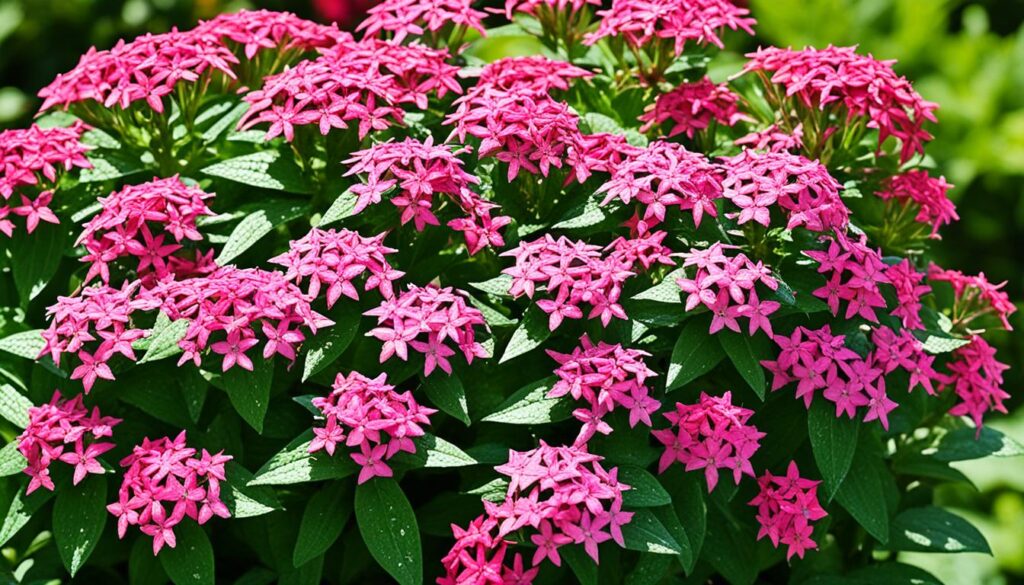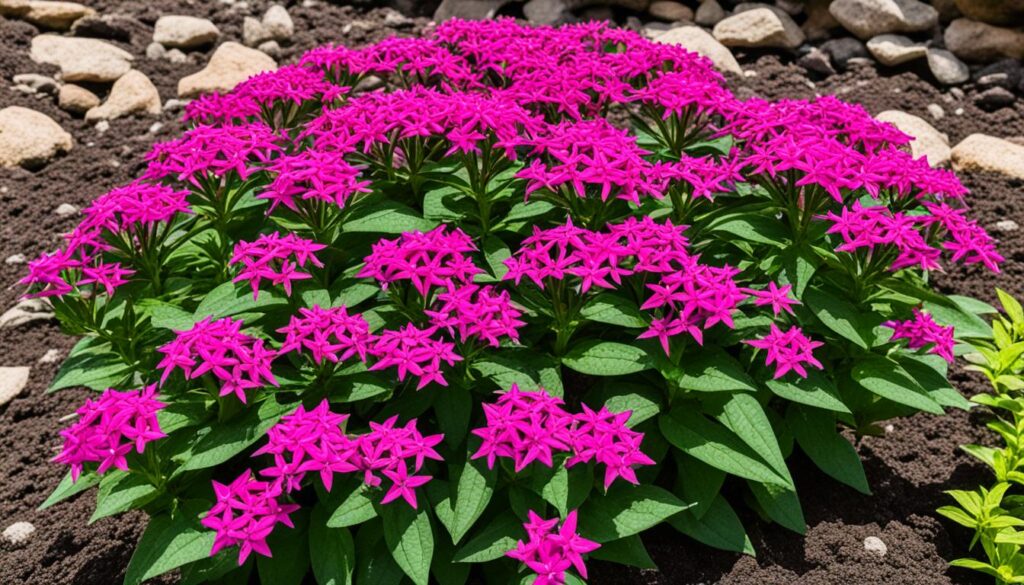Welcome to the complete Pentas care guide. It’s here to help you grow your pentas plants for beautiful garden blooms. Pentas are loved for their star-shaped flowers and attracting pollinators. This guide gives you tips and advice for all gardening levels.
Learn how to pick the right pentas variety and care for them. We cover soil, sunlight, and watering. You’ll find out how to feed your pentas, keep pests away, and plant at the right time. This guide will turn your garden into a paradise. For more on growing plants, check out this plant growing guide.
Introduction to Pentas: The Flowering Star
Pentas are often called the «flowering star» because they add beauty to gardens. They come from East Africa and grow well in many places. These plants are great for attracting hummingbirds and butterflies to your garden.
They are easy to take care of, perfect for gardeners who want lovely flowers with little work. Pentas love the sun and need soil that holds moisture well. They can grow 2-3 feet tall and come in colors like white, pink, purple, lavender, and red.
Learning about pentas can help you make your garden more beautiful. They can handle drought and like humid places. To help them grow, water them right and use a special fertilizer for more flowers.
Adding pentas to your garden is a great idea. They can be paired with other plants for more color and beauty. Taking good care of these plants will keep your garden lively.
Learn more about garden care tips and how to enjoy your pentas.
Understanding Different Pentas Varieties

Pentas plants are great for home gardens. They bring bright colors and attract bees and butterflies. There are many types of pentas that do well in different places. Knowing about these can help make your garden look amazing.
Popular Pentas Species for Home Gardens
Some top pentas species for gardens are:
- Lucky Star series – It’s small and comes in many colors, great for small spaces.
- Starburst series – These flowers are bright and attract many pollinators, making your garden lively.
- Pinkie – This type has soft pink flowers and looks good with other plants.
Learning about these options helps you pick the best one for your garden.
Selecting the Right Variety for Your Climate
Choosing the right pentas depends on your climate. Most pentas do well in zones 10–11, which are warm. Think about these things when picking your pentas:
- Look at your local weather – Some pentas don’t like cold, so pick wisely.
- Consider container gardening – If it’s not warm where you live, put pentas in pots. You can move them inside when it gets cold.
- Think about how much sun and water they need – Each type has its own needs.
Picking the right pentas for your climate means you’ll have a garden that looks great and stays healthy.
Pentas Care Essentials: Sunlight and Watering

To get your pentas to bloom well, you need to know about sunlight and watering. These plants need the right amount of sunlight and water to stay healthy. This part will tell you how much sunlight they need and how to water them right.
Optimal Sun Exposure for Vibrant Blooms
Pentas need full sun for at least six hours a day. This helps them grow well and bloom brightly. Make sure they’re not in the shade from buildings or other plants.
You might need to move them a bit with the seasons to keep them in the sun. This helps them grow bushy and bloom more. It makes your plants look better.
Watering Techniques for Pentas Plants
Watering your pentas is key to their life and growth. They can survive with less water, but they do best with regular moisture when they’re growing fast. Check the soil often to see if it needs water.
Use good watering methods like:
- Soaker hoses to slowly give moisture to the soil.
- Drip irrigation systems for a steady water supply.
- Manual watering during dry times, making sure the water goes deep into the soil.
Creating a watering schedule and using smart watering ways helps your pentas look great in your garden.
| Watering Technique | Description | Benefits |
|---|---|---|
| Soaker Hoses | Deliver moisture directly into the soil, minimizing evaporation. | Efficient watering and reduced fungal risks. |
| Drip Irrigation | Provides a controlled and steady supply of water. | Helps avoid overwatering and encourages deep root growth. |
| Manual Watering | Allows for flexibility in watering based on immediate needs. | Provides direct insight into soil conditions. |
Pentas Soil Requirements and Fertilization

Pentas plants are easy to care for and have vibrant blooms. They need the right soil and fertilization to grow well. Choosing the right soil and fertilizers makes your plants healthier and more vibrant.
Choosing the Right Soil Type
Pentas love well-draining soil that keeps moisture but doesn’t get too wet. Mix loamy or sandy soil with organic matter for the best results. This mix gives nutrients and good drainage. A pH level between 6.0 and 7.0 is perfect for pentas to get nutrients well.
Good soil helps pentas grow strong roots. Strong roots mean healthier plants and more blooms.
Fertilizing Options for Healthy Growth
Fertilizing pentas is key for lots of blooms. Use slow-release granular fertilizer when you plant them. Then, give them water-soluble fertilizer every 4 to 6 weeks while they grow.
This keeps them healthy and makes them bloom more. There are many ways to fertilize, so find what works best for your garden.
Pentas in Landscaping: Adding Color and Life
Pentas are more than just beautiful flowers. They make landscapes colorful and lively. Using pentas in your garden makes it look better and work better. This part talks about how to use pentas as ground cover and in containers. It gives tips for a beautiful garden.
Using Pentas as Ground Covers
Pentas are great as ground cover plants. They fill in gaps in garden beds with color. Here are some tips:
- Plant pentas in groups for a bold color display.
- Pair them with plants that resist drought for beauty and function.
- Think about the growing season for continuous blooms.
Adding pentas to your garden brings beauty and helps nature. It attracts pollinators and good insects.
Pentas in Container Gardening
Pentas are perfect for container gardens, especially in small spaces or cooler areas. The right pots and plant arrangement make a beautiful display. Here are some tips:
- Use containers with drainage holes to avoid waterlogging.
- Combine pentas with other plants for interesting visuals.
- Water and feed your containers regularly for healthy plants.
This way, you can enjoy pentas’ bright colors in small spaces. Think about ideas from global partnerships focused on uplifting education for gardening success.
| Aspect | Ground Cover Plants | Container Gardening |
|---|---|---|
| Space Requirement | Needs more ground area | Flexible; fits small spaces |
| Watering Needs | Needs steady moisture | Needs regular care |
| Design Flexibility | Has a set arrangement | Can change with containers |
| Seasonal Adjustment | Stays the same seasonally | Can change with containers |
Tropical Pentas: Bringing the Tropics to Your Garden
Tropical pentas add a pop of color and exotic charm to any garden. They have unique flower clusters and fragrances. The ‘Tropical Star’ variety shows off their lush beauty and toughness, bringing the tropics to your yard.
Features of Tropical Pentas Species
Tropical pentas are known for their tough nature and bright blooms. These plants have:
- Vibrant colors: They come in red, pink, and white, making your garden look amazing.
- Flowering ability: They have many star-shaped flowers that attract butterflies and bees.
- Resilience: These plants can handle tough weather, making them great for outdoor spots.
- Low maintenance: They are easy to care for, perfect for both new and experienced gardeners.
How to Grow Tropical Pentas Indoors
Indoor tropical pentas can brighten up your space and boost your mood. Here are key tips for growing these plants inside:
- Optimal lighting conditions: They need six hours of bright, indirect sunlight a day. A south or west window is ideal.
- Temperature requirements: Keep the temperature between 65°F and 80°F (18°C to 27°C). Avoid sudden changes in temperature.
- Watering practices: Water them when the top inch of soil is dry. Make sure the soil drains well to prevent root rot.
- Fertilization: Feed them a balanced fertilizer every four to six weeks to help them grow and bloom well.
- Humidity levels: These plants love high humidity. Using a humidifier or keeping them together can help keep moisture levels up.
Creating a mini-tropical spot at home lets you enjoy tropical pentas all year. Their bright colors and energy can make your indoor space feel lively.
Common Pests and Diseases Affecting Pentas
Pentas plants are loved for their bright flowers. But, they can face pests and diseases that harm their growth and look. Spotting these problems early is key to keeping your garden healthy. Knowing what pests and diseases to watch for helps keep your plants strong and your garden beautiful.
Identifying Common Pests
When you care for your pentas, you might see pests like:
- Aphids: These tiny insects stick to new growth, causing leaves to wilt and look odd.
- Spider Mites: Hard to see, these tiny pests make leaves look speckled and create webs.
Pentas can also get leaf spot diseases. These come from fungi like Alternaria, Colletotrichum, and bacteria like Pseudomonas. You might see spots on leaves that can be yellow, black, or have rings. Sunken spots mean the disease is worse.
Preventative Measures and Treatments
To stop pentas problems, keep your garden clean and watch your plants closely. Here’s what to do:
- Check and fix soil health with tests and changes.
- Don’t let leaves stay wet by watering from below.
- Give plants enough space for air to move around them.
- Take out dead or dying parts to stop disease spread.
If you see leaf spots or pests, try organic ways to fight them. Use organic fungicides early to work best. For more help, talk to local gardening experts. Check out gardening tips to prevent diseases and keep your plants healthy.
Tips for Growing Pentas at Home
For those who love gardening, growing pentas at home is rewarding. Choose a spot that gets lots of sunlight. Pentas love bright, warm places.
Make sure they get at least six hours of direct sunlight each day. This helps them grow well and stay healthy. Keep an eye on the soil’s moisture to know when to water them.
Pruning is key for pentas. Trim back long stems in early spring to make them bushier and more bloomy. Good air flow around the plants keeps pests away. Use organic fertilizers often to feed your pentas well.
Seasonal care is important for pentas. In warm seasons, watch for changes in light and temperature. You might need to give them more shade or water. As fall comes, cut back on watering a bit but watch for pests.
By following these tips, you can grow beautiful pentas at home. Your garden will be full of color and life.



